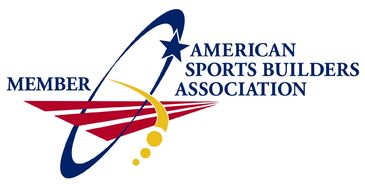Call us today for more information! 313-779-8415 Laser Sport Surfacing and Striping
Maintenance Tips

CLEAN REGULARLY
Once a month is suggested. Watch for evidence of mold or mildew in shaded areas and corners where organic debris ten to accumulate. Acrylic coatings do not support fungus growth, so growth of fungus or mold is a result from food and drink spills, decaying matter, or other foreign materials on the surface feeding these organisms.
To remove mold, fungus and other organisms on the surface use: two parts household bleach, mixed with one part water. Use the solution to treat affected areas, scrub gently with soft bristled brush and rinse thoroughly after a few minutes. Rinsing your surface with water is usually sufficient for general cleaning. If there are visible stains on the court surface, a mild detergent can be applied prior to gentle scrubbing with a soft bristle brush. The suggested mild detergent formula: combine four parts water with two parts TSP (Trisodium Phosphate) and one part household bleach (when mildew present).
When using a pressure washer or water broom, limit pressure to 70 p.s.i. A pressure washer should not be used regularly. The pressure can pull the sand from the coatings, making the play area slippery.

REMOVE FOREIGN MATTER / STANDING WATER
Leaves and pine needles can not only stain your court, but also are breeding grounds for mold and mildew. It is especially important to remove leaves in the fall and keep your court free of debris all winter.
Rain showers help clean your court. However, dirt accumulates in standing water, leaving stains and piles of debris. This acts like sandpaper under players' feet and creates abrasion on the surface. Remove water from birdbaths as often as possible. Also, be sure to avoid lawn sprinklers spraying on the court regularly.

DRAINAGE IS KEY
Drainage is very important to the success of your sport surface. Excess water that flows back onto the surface or beneath the court can cause many problems, including major cracking. Landscaping is important, be sure vegetation does not block any drains or swales. Keep grass and any other vegetation trimmed and away from the court surface as well, to allow adequate drainage of the surface.

REPAIRS AND RESURFACING
If there are any small hairline cracks that appeared over the season, seal with a clear acrylic waterproof sealer and a plastic paddle before freezing temperatures.
The asphalt base of a sport surface, no matter how well built, can exhibit cracking and low spots known "birdbaths". There are many factors that can contribute to these problems including: ground movement and sinking, tree roots, improper base mixes and drainage. While the court owner can handle many of the cleaning and protection, keep in mind that surface repairs and resurfacing is best handled by sport surfacing professionals.

CUSHION SYSTEM REPAIRS
When performing future repairs on a cushion system, try to use rubberized or flexible acrylic products to make the repairs. An elastomeric, or flexible crack sealant, is ideal for filling cracks that may open in the surface. This would complement the softness of the surface versus using a hard crack filling method. Low spots that create ponding of the surface should be filled with additional coats of cushion. Coarse cushion can be built up in layers to do most of the filling and a fine cushion layer can fill in the small remaining voids before resurfacing. If the low spot is deeper than 1/4", acrylic patch binder mix may be used. However it may leave a slightly noticeable "harder" spot.
About Us

Copyright © 2025 Laser Sport Surfacing - All Rights Reserved.
Powered by GoDaddy